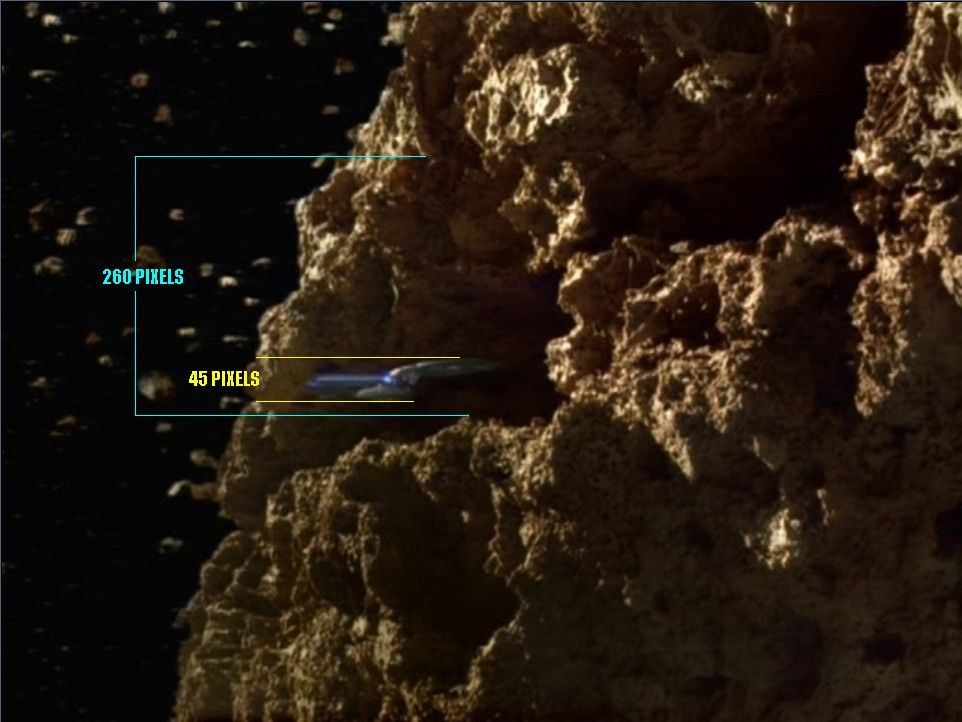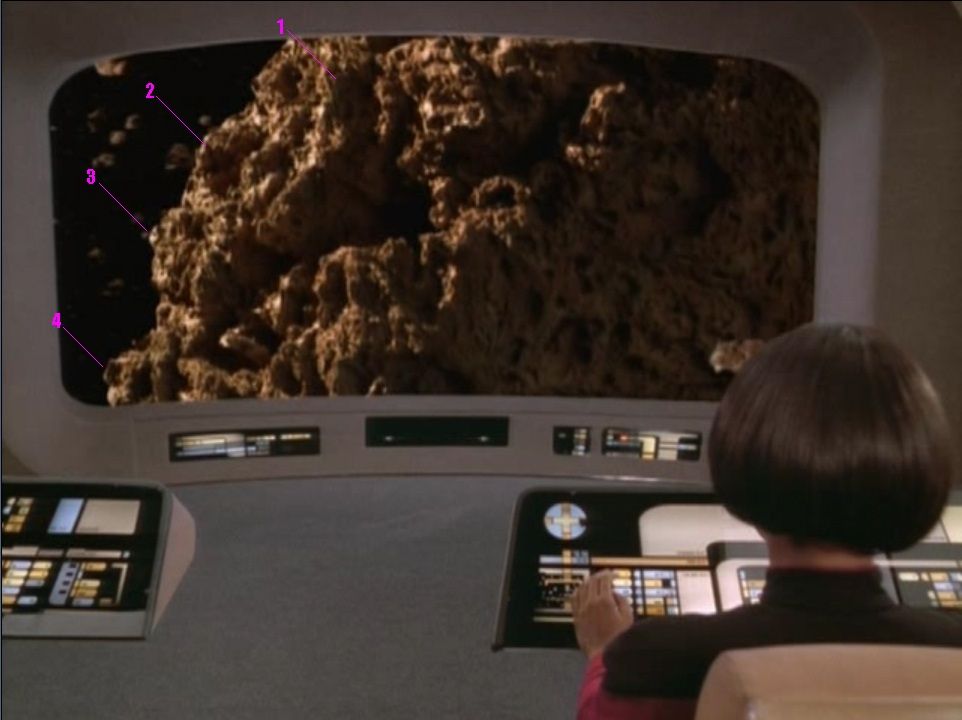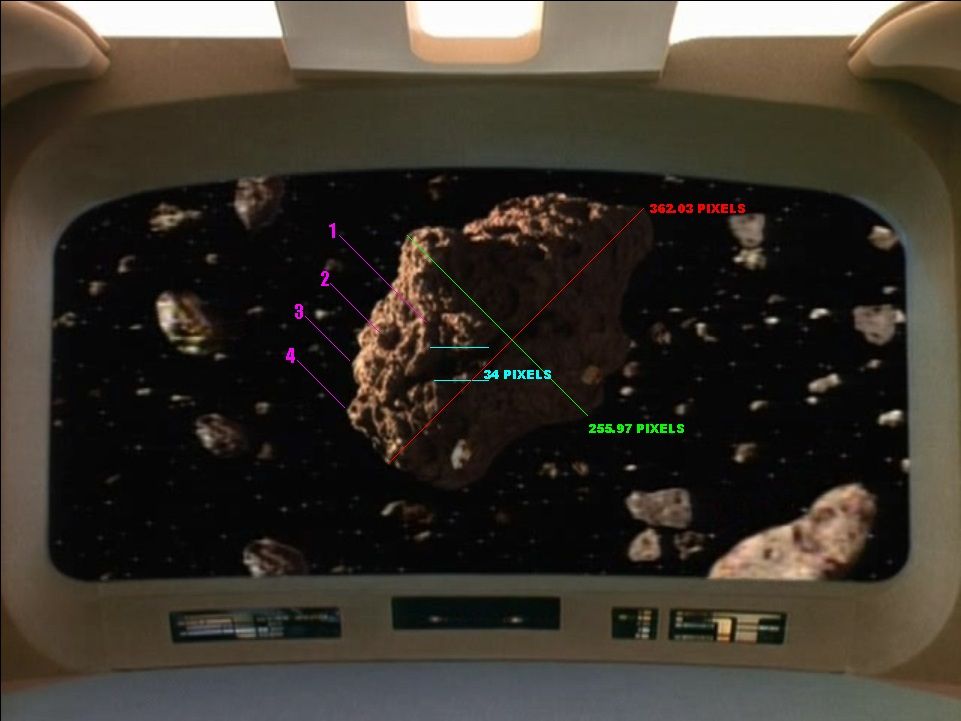Mike DiCenso wrote:The images and scaling you provided are vivftp's from SB.com. It has several problems, namely it does not take into account lightning differences in the images used, so he winds up making the mistake of choosing the larger chasm structure, rather than the smaller, very similar one to the left of it, which would result in doubling the asteroid's size to around 12 x 18 km. In both his and Wong's case they assume that the asteroid is going to be merely shattered, and that there will not be signficant vaporization/melting involved in it's destruction.
-Mike
It's actually very accurate. There are four patterns which viv points to, but there are many more which we can spot as well, when you consider that the asteroid has spun.
I could make those patterns clearer if you wish to, but I'd rather be sure you've looked at the pic properly before I go into the trouble of fiddling and uploading pictures.
Jedi Master Spock wrote:Mr. Oragahn wrote:I can't remember what AMOT is about, but I know for sure that Masks certainly does not point to high figures. Much on the contrary.
"A Matter of Time" involves drilling for carbon dioxide pockets. It's most famous for the .06 terawatt maximum variance, and the threat to accidentally burn off the planet's atmosphere.
A planet atmosphere doesn't suddenly burn as a whole just because of a variance of 60 gigawatts.
It certainly does.
For every cubic kilometer of typical comet-density snowball (.5 g/cc) that is turned into dissipating vapor, you have to come up with 600-700 megatons of energy. If you're superheating it - one possible explanation for the luminous yellow effect in the melt zone and the swift dissipation of gases - that can nearly double.
We have an initial state, we have a final state. The scaling of the comet is disputed, but regardless of which scaling you use, we have a multi-gigaton event.
Maybe on the long term, but the whole a major issue was not about the total energy needed there, but the power. Evidence varies greatly, from dozens of seconds to far more than one hour.
We also have the problem that Geordi talked about
melting the comet, which is surprising coming from a man with his pedigree. The other problem is that these weapons are phasers, not mere lasers, with effects such as "eating" matter without much expected heat radiation when vapourising the corresponding volumes of targets.
Besides, talking about the overall energy, it all depends on the volume of ice, and that's not only obtained by gauging the width of the comet, but also by considering the size of the big station stuck inside, which was composed of several monolithic sections.
Pegasus is very open ended, but certainly does not even approaches the craziest stuff of TOS.
Does it?
This asteroid looks to be larger and more massive than the ones destroyed by the Romulans in "Balance of Terror." It possibly even exceeds the volume of rock melted by the
Enterprise's maximum strength phaser blast in "The Paradise Syndrome," and I suspect there's going to be a higher energy density involved in the putative "Pegasus" incident.
Thus far, the 8.5-10 km scaling I have in mind, obtained from the accurate pictures I linked, have me consider my initial opinion correct.
In fact, the "blast out of the asteroid using phasers" plan involves quite a bit of firepower too. We're dealing with on the order of a cubic kilometer of rock here.
With phasers that eat matter. It's also interesting to notice that while the Romulans could melt the rock without damaging the asteroid, the E-D couldn't use her phasers without taking a great risk at collapsing the chasm because the asteroid's structure was too unstable. The denser an object, the less brittle.
As I said, it's a bloom, not a flash... but I also modeled it as a flash of light. Same results.
Guess what? Solar intensity illumination at a 187.5 km radius means your source is putting out 4*pi*(187,500m)^2*1.4 kW/m^2 = 620 terawatts of radiation in the visible range. Overall, we see about a petajoule of luminous energy right there. And what percentage of the energy of a matter/antimatter weapon is going to go out in the visible spectrum in two seconds?
Well, in general, based on what we know about M/AM reactions and nuclear tests within atmosphere... initial visual flash is going to be a pretty small fraction of the yield. Maybe 0.1% if you're lucky. Whoops. We went over a gigaton, again.
Of course, there's a little bit of flex in those figures, but not much. I went over this a lot at ST.com in horrific detail. No matter what physical phenomenon you model that little beige circular thing as, barring unreasonable assumptions (such as assuming the planet is nowhere near Earth-sized) wind up in the general neighborhood of e18-e19 joules based on the scale and speed of effect.
What you used is a sound method, which would be quite useful in a better context, with effects of greater quality, but I disagree on the luminosity you considered.
We are nowhere there, even for the three or four frames long flash that precedes the blooming explosion.
Besides, brightness, or lack of thereof, is not the only parameter to consider. Flash and fireball duration are just as important, and these severely disagree with such a level of firepower.
Finally, the fireball itself largely exceeds the width of the flash, which is a severe problem notably due to how light scaterring works in an atmosphere, where the flash will dominate in terms of luminosity over a same area.
Then, as a second part of this case, we have to consider how antimatter really does act upon reaction, and how pions behave.
Knowing little about such reactions, I googled around.
I propose that excerpt from wikipedia:
Over 99.9% of the mass of neutral antimatter is accounted for by antiprotons and antineutrons. Their annihilation with protons and neutrons is a complicated process. A proton-antiproton pair can annihilate into a number of charged and neutral relativistic pions. Neutral pions, in turn, decay almost immediately into gamma rays; charged pions travel a few tens of meters and then decay further into muons and neutrinos. Finally, the muons decay into electrons and more neutrinos. Most of the energy (about 60%) is carried away by neutrinos, which have almost no interaction with matter and thus escape into outer space.
The overall structure of energy output from an antimatter bomb is highly dependent on the amount of regular matter in the area surrounding the bomb. If the bomb is shielded by sufficient amounts of matter, the gamma rays are absorbed and the pions slow down before decaying. Part of the kinetic energy is thus transferred to the surrounding atoms, which heat up.
In a case where no matter would be present, we are told that around 50-60% of the energy is lost through neutrino radiation.
However, the casing of a torpedo would be most important to guarantee a maximum efficiency to prevent the low interactions muons and neutrinos from sucking out all the energy, as much as the gamma rays from flying away until they get stopped by denser elements.
Basically, the presence of the ground, the atmosphere and the torpedo's own shuttle would lead to a greater amount of matter being heated up, which has me strongly question the luminosity of the flash in this case representing only 0.1% of the weapons's yield, if we are lucky.
Then we still have to consider the creature itself, Armus, capable of shutting down many of a
type 7 shuttle's systems, while the shuttle was away from Vagra II. Considering the lack of information for this planet, Troi's shuttle was more than likely capable of warp, thusly powered by a more than decent warp core. Which would surely add a decent amount of power to the final explosion.
As I said, we have to completely consider the creature's abilities.
Armus could withstand phaser shots easily, would actually feed on their energy... so we can't even know how much energy it's been previously absorbing, it could even be possible that the desert state of the planet would be a result of the vampire creature.
It also was generating a field blocking the E-D's transport beam (even if the E-D was running on low power due to maintainance).
It could use telekinesis and even phasing objects away. It ate Riker and turned him into nothing, but could still torture him, whatever form it was under at that time.
That creature alone seems to be the sum of perverted power from a whole civilization of individuals who seemed to possess powers.
An impressive aspect, however, is how fast the torpedo closed on the planet.
Taking your 187 km range, this would correspond to roughly 1.7 second.
I am not sure if this would fit with the vast majority of torpedo speeds though.
Besides, the point is making the averages when there are great variances. TNG+ has many references, and you can find a middle ground with eventually top petawatt ranges from warp core, a percentage of that being diverted to phasers, and two digits, maybe three digits for torps; although again in theory a low gigaton torp should be no problem there.
The problem is what kind of average I take. If I take the arithmetic mean, then if I count Spock's claim to be able to
split in two pieces something half the size of the moon, and divide by a hundred cases in which little is done, then I'm still in the multi-gigaton range - and it's a very weak example to start with, especially since the phasers don't have that huge of an effect.
Of course this would certainly not be an average of the vast bulk of TNG+ references.
The real problem to be how Gene Rodenberry has retconned certain aspects of Trek. The most obvious recton being the flight speeds.
I don't believe he actually retconned those. The TOS "backstage" scale is one of the slowest scales available, and had nothing to do with actual TOS speeds. Likewise with TNG.
I've heard a complete different story about it. It would probably be worth its own detailed investigation, but I read people reporting Gene wanted the speeds to be slower, otherwise there couldn't be much exploration - which is absolutely right.
Eventually, that ounce of antimatter thing could be rationalized if we really pushed it hard, by implying volume, a high concentration, checking out what 10,000 cobalt bombs means in that context, and that the atmosphere itself only needed a something to start going through an exotic chain reaction.
Still, there's that sound wave of jaw dropping power, where rationalization is harder.
And the matter of how much atmosphere the planet has, how large the planet is... et cetera. I'm inclined to treat that one as a simple scientific error, personally.
In what sense?
But as a whole, the pattern is that for TOS, rationalization is used to lower figures, while in most of TNG and late Trek, it's used to increase them.
Er... not really. As a rule, I rationalize far fewer examples than I discard. I mostly take figures, discard all the ones that I can't fit to within a generous MOE, and then run with what seems reasonable from there in making my final estimate. I also consider the relative strength of the example. SOE is quite strong as a "lower bound" type estimate, but it is not very precise.
I have chosen a gigaton as a probable maximum torpedo yield not based on the maximum possible yield seen in effects. A reasonable estimation for every firepower example includes a number of ranges that go well past the gigaton mark when considered carefully - but the amount of antimatter stored on a torpedo seems sharply limited.
TDIC I choose to discard when analyzing firepower. The order of magnitude of firepower required to physically disassemble a planet is simply not compatible with the other cases. Similar with STV. That sheer speed and range is very difficult to reconcile with most later examples.
"Where Silence Has Lease" gives one of the highest speeds of any episode... and it's for
warp 2. I prefer to place that one in the outlier column as well, though I may consider it when picking my median path.
But what appears to be outlier material from TOS seems to also correspond to ungodly magnitudes, either about this ounce of antimatter or the sonic attack. Even TDIC pales against that.
You call them problematic, I suppose, in the context where someone would like to make all yields worth of the TOS craze.
Like I said, there really aren't more low-yield than high-yield examples in the TNG+ era. TDIC is the singular most egregious example, but some of the most high-energy events happen in Voyager and DS9. I pointed out just how much more lethal the Delta Flyer's projected warp core breach is than the detonation of Dreadnought's warhead.
The million kilometer safe distance?
I'm checking the transcript of Drive
here.
This is clearly a problematic case as well.
I didn't see the episode. They mention a shockwave at the end, while the explosion occured one point two million kilometres from Voyager's position. And the nebula was supposed to contain the explosion. What happened with that shockwave? Was the ship shaken?
Huh, from what I've read, TOS enabled speeds which had ships cross a galactic radius in less than a day.
OK, please read
this page. While there are a number of examples that seem pretty loose, every incident in which the old Constitution-class Enterprise definitely travels 30,000 or more light years within one day involves hijacking. All but STV involve highly advanced aliens. As I've said, STV should be discarded as an outlier. Speeds in TOS under conventional warp power in general do not exceed 1 million times lightspeed, although they sometimes come close, and usually are not sustained for more than a couple thousand light years at a stretch.
As a whole, TNG+ really got below that.
Below
and above.
To me the "aboves" from later Trek are only distant echoes of the TOS effect, artifacts.
You don't get that above when that blue ball transported by Kirk and maybe Spock was capable, once filled with AM from the warp core of the E-nil, to leave a continent scale scar across the surface of a planet with a 9.8 gravity and breathable atmosphere... which is gone as well. There's actually no cloud to observe at all, no haze of dust around the planet whatsoever.
Again, another nonsensical event? Sure, it looked nice, but is it possible? Nope.
Voyager explicitly gives the highest hazard-to-mass ratio for a vessel with the Delta Flyer in "Drive." Do you know how many teratons you need to destroy all light vessels within a million klicks? Just killing unprotected humans at that distance is difficult.
I'm not aware of this case. What's the reference exactly?
But, in the end, maybe Trek on the average can have yields tickling the gigaton range without any problem.
If you really want to see if this reality works better than the more moderate ones argued by other people, you could still try to talk to a debator from SDN, or SBC, and actually defend that position.
Maybe you (JMS) could get some decade old misconceptions corrected, and possibly increase the averages.
So, what do you say? This would surely revive the debate.
I've talked with some SDN/SB residents of the anti-Trek persuasion on ST.com. Mostly, they don't seem to listen to the evidence regarding any high power or high speed example, preferring to try to rationalize it away in various irrational ways.
If you want a true average, I could throw them all together and average, but I'd probably wind up with something unreasonably high thanks to the occasional truly ridiculous example.
The main and obvious problem being that your posts were diluted into a thread which, if it's the one I'm thinking about, was galaxy-cluster wide.
If you actually make a solid case on a much more focused discussion, even a duel, readers will fairly know when the oponents are in denial and use unacceptable argumentation tactics, it's extremely easy to spot after all (we had some examples highlighted in the "other forums" section).
My curiosity is most genuine on that. If one person, Trekkie or not, claimed he/she had a strong set of evidence for 3 or 4 digits megaton range for UFP torps, the challenge would be for the other side to actually show that there's ample evidence to counter that claim.
For example, although I believe torps sit in the low 3 digits megaton range at best, they're also dialable, which offers a good margin of interpretation, notably for people like you who think they're more powerful than that.
If you had to start a debate with an active and effective Trek "nerfer" (w/o offense), who would you pick?


